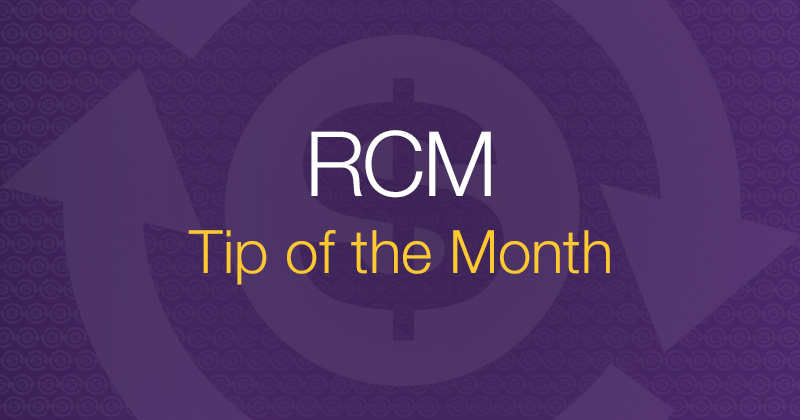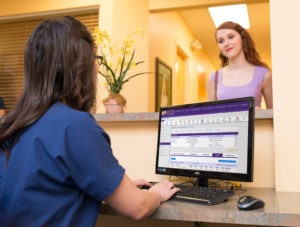RCM Tip #5: Charge for Missed Appointments

Do you have an effective no-show policy in your ophthalmology practice?
Checking up on denials, reconciling accounts and following up on patient payments may be at the bottom of your to do list, but keeping up with the operational and financial functions of your ophthalmology practice are essential to providing top-notch patient care and can help ensure long-term business success.
Each month, I will provide a revenue cycle management tip to help you collect payments more efficiently and improve the overall revenue flow for your medical practice. This month, I am focusing on how to create and implement a patient no-show policy in your ophthalmology practice to help recover some of your lost revenue.
As an ophthalmologist and practice owner, your time, effort and services cost money. While that may seem obvious, sometimes patients need to be reminded of the business side of healthcare. Charging patients for missed appointments, may cause them to think twice about skipping out on visits without notice or communication.
Financial Impact of Patient No-Shows
Missed appointments can have a significant impact on your business. In addition to the extra effort required by your staff to follow up and reschedule, there is lost time and opportunity for serving other patients and no revenue from the no-show.
According to a report by the Medical Group Management Association (MGMA), the average no-show rate for most medical specialties is 5 percent. Surprisingly, only a quarter of practices reported they charge any sort of missed appointment fee to help recoup some of the lost revenue.
To figure out how this is impacting your bottom line each month, take the average patients you seen in a month, multiply it by your no-show rate, then multiply that result by your average revenue per appointment. You may be surprised to find out that you are missing out on a good chunk of revenue that could be recovered by implementing a more effective no-show policy.
Guide to Developing a No-Show Policy
Developing a no-show policy sounds simple, but you shouldn’t overlook all of the specific details like cancellation timeframe and reasonable no-show fee amounts. You should also think through how you and your staff will communicate this no-show policy to your patients and how your front office staff will enforce the policy when patients miss their appointments.
Your no-show policy should include clear terms, such as patients that cancel their appointment within 24 hours, miss their appointment or show up more than 30 minutes late may be liable to pay a set no-show fee.
If a patient misses more than one appointment, you may want to consider only offering them certain time slots like the last one of the day or just before lunch, in an effort to keep the integrity of your daily schedule intact.
Determining Your No-Show Fee Amount
The no-show fee is ultimately up to your discretion, but keep in mind that the fee is intended to reflect the missed business opportunity, not necessarily the total amount you could have received if the appointment had taken place. On average, no-show fees fall into the $25-$75 range.
No-show fees should be substantial enough to deter your patients from thoughtlessly blowing off appointments, but affordable enough for your patients to actually pay. Additionally, you don’t want to charge an unreasonable fee that could upset your patients, giving them a reason to leave negative feedback on social media or health provider review sites.
Putting Your No-Show Policy into Practice
As with any new office process, implementing a missed appointment fee policy will take some cross-functional team effort and training. Your practice’s policy should be communicated to the patient at the time the initial appointment is made, whether by your front office or through an electronic scheduling platform.
You may even want to have patients sign a no-show policy acknowledgement as part of their initial paperwork, officially informing them upfront of the conditions and financial repercussions of missing their appointments.
 Your staff should document missed appointments or patients that cancel their appointment within 24 hours in your scheduling or ophthalmology practice management software. This will help keep track of which patients owe no-show fees or who may be repeat no-show offenders.
Your staff should document missed appointments or patients that cancel their appointment within 24 hours in your scheduling or ophthalmology practice management software. This will help keep track of which patients owe no-show fees or who may be repeat no-show offenders.
Any no-show fees should be clearly listed in patient balance statements for collections. Some payer contracts allow you to collect patient payment information upfront, which may allow you to automatically collect a fee if the patient misses his or her appointment.
Patients should be contacted promptly via phone or email regarding their missed appointment and reminded of the policy and fee. Your staff should also be trained on how to handle patient inquiries and how to collect on outstanding patient balances.
From a clinical perspective, you may also want to consider implementing a daily or weekly chart review of patients that have missed their appointments to determine if further follow-up with the patient is needed. In these cases, your front office staff may need to proactively reach out to the patient for rescheduling options.
Practice Management Tools to Address No-Shows
The two most common reasons patients miss appointments are:
- They incorrectly noted their appointment time, or
- They simply forgot about the appointment
 One of the easiest ways to avoid this issue is to implement a patient reminders process. However, this can be a very manual and time consuming task for your front office staff.
One of the easiest ways to avoid this issue is to implement a patient reminders process. However, this can be a very manual and time consuming task for your front office staff.
Instead of having your staff log hours of calls and messaging each day, some advanced practice management platforms provide robust patient reminder tools that can handle your reminder emails, calls and text messages for you.
Having these patient reminder tools that interface with your ophthalmology practice management software can automatically update a patient’s appointment status and notify your staff if a patient has requested rescheduling. Proactive communication can also go a long way in reducing missed appointments and nurturing the patient relationship.
If you do have a patient that misses their appointment, your ophthalmology practice management system should include the ability to charge the patient your set no-show fee through a custom charge function and add it to the patient balance. With patient balance information clearly listed, your front office staff can easily collect these balances at check-in or checkout of their next appointment.
RCM Services Can Help with Your Patient Collections
If you run a small, independent ophthalmology practice, it can be near impossible to burden your front office staff with communicating and enforcing the no-show policy and staying on top of patient collections, in addition to all of their other daily tasks.
If this all sounds a bit overwhelming, it might be a good time to consider using a third-party revenue cycle management service that specializes in ophthalmology billing and patient collections.
Dedicated revenue cycle specialists can help offload billing and claims management processes from your staff, addressing the full revenue cycle from before the patient is seen until the balance is collected. They can mail out patient balance statements, offer a hotline for inbound patient billing inquiries, place outbound automated patient balance calls, and accept payment collection from your patients.
By using an ophthalmology RCM service that is seamlessly integrated with your practice management platform, you can maintain visibility of your practice financials and dedicate your time and energy to patient care. In this video, Maria Ruttig, Practice Administrator for Eye M.D. of Niceville shares her experience with Modernizing Medicine’s RCM solution.
